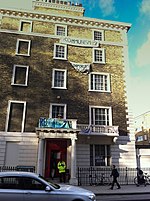Warburg Institute

The Warburg Institute is a research institution associated with the University of London in central London, England. A member of the School of Advanced Study, its focus is the study of cultural history and the role of images in culture – cross-disciplinary and global. It is concerned with the histories of art and science, and their relationship with superstition, magic, and popular beliefs. The researches of the Warburg Institute are historical, philological and anthropological. It is dedicated to the study of the survival and transmission of cultural forms – whether in literature, art, music or science – across borders and from the earliest times to the present including especially the study of the influence of classical antiquity on all aspects of European civilisation. Based originally in Hamburg, Germany, in 1933 the collection was moved to London, where it became incorporated into the University of London in 1944.
Excerpt from the Wikipedia article Warburg Institute (License: CC BY-SA 3.0, Authors, Images).Warburg Institute
Woburn Square, London Bloomsbury (London Borough of Camden)
Geographical coordinates (GPS) Address Nearby Places Show on map
Geographical coordinates (GPS)
| Latitude | Longitude |
|---|---|
| N 51.52331 ° | E -0.13013 ° |
Address
Woburn Square
Woburn Square
WC1H 0AA London, Bloomsbury (London Borough of Camden)
England, United Kingdom
Open on Google Maps







